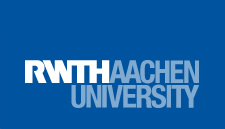Kategorie: ‘Energie und Umwelt’
Professor Antonello Monti Receives NRW Innovation Award
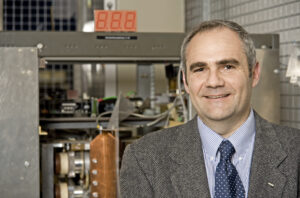
© Peter Winandy
Professor Antonello Monti is not only the holder of the Chair of Automation of Complex Power Systems, but since the end of May 2022 he has also been the winner of the Innovation Award of the Federal State of North Rhine-Westphalia. Awards were made in the categories “Honorary Award”, “Young Researchers” and “Innovation”, with Professor Monti being honoured in the “Innovation” category. This innovation prize is endowed with 100,000 € and is thus only second to the Future Prize of the Federal President in Germany.
With the award, the federal state recognises excellent research with particular social significance, scientific potential and relevance in application. In the case of Professor Antonello Monti, it is pioneering work in the digitalisation of power systems , which has great relevance for the energy transition.
In detail, it is a new concept for the automation of modern energy networks, which is based on modern IT solutions and enables a modular approach. The development as open source supports the cooperation of all participants and the creation of an open ecosystem.
The award was presented by the Minister President of NRW, Hendrik Wüst, and Professor Andreas Pinkwart, the NRW Minister for Economic Affairs, Innovation, Digitalisation and Energy.
For more details, see the official RWTH press article.
New Publication by Professor Lemme and Colleagues
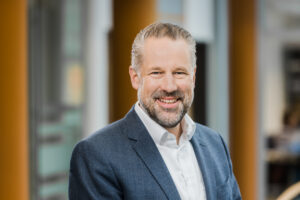
Portrait of Prof. Lemme (© JRF)
Healing Achilles heel of two-dimensional transistors
Stability – in the sense of stable operation thorough lifetime – is one of the key characteristics that an electronic device need to present to be suitable for applications. And it is the Achilles heel of transistors based on two-dimensional materials, which typically show much worse stability than devices based on silicon. A team of researchers from TU Wien, AMO GmbH, RWTH Aachen University and Wuppertal University has now demonstrated a novel engineering approach to enhance the electrical stability of two-dimensional transistors by carefully tuning the Fermi energy. The results have been reported in Nature Electronics.
Today, there is little doubt that devices based on graphene and other two-dimensional (2D) materials can exceed the state of the art for certain applications, thanks to their intrinsic properties. Two-dimensional materials are also seen as some of the most promising candidates for realizing ultimately scaled transistors at the end of the roadmap of silicon technology. However, devices based on 2D materials often show poor electrical stability, meaning that their behavior changes depending on their operation history.
“Component reliability is one aspect that is often neglected in research. This is precisely where we have been working for several years, because it is of central importance for applications.” explains Professor Max Lemme, scientific director of AMO GmbH and Head of the Chair of Electronic Devices at RWTH. The instability is not only caused by 2D materials themselves, but mostly by charges trapped into the oxide-insulator used to fabricate the transistors. “Ideally, one would like to use a different insulator with fewer charge traps,” says Lemme, “but there are no scalable solutions for this yet. In our work, we have shown instead that it is possible to use a standard insulator such as aluminum oxide and to significantly suppress the adverse effects of the charge traps in the oxide, by adjusting the charge carrier density in the 2D material.”

© Martin Braun
The work combines a thorough theoretical analysis of the novel approach – dubbed by the authors ‘stability-based design’ – and a proof of principle demonstration of the concept, performed by measuring different types of graphene-based FETs. The key idea of the approach is to try to engineer the combination 2D-material/insulator in such a way that the energy of the charge traps in the insulator is as different as possible from the one of the charge carriers in the 2D material. Lemme explains: “Graphene based FETs were the ideal test bed for our approach, as it is relatively easy to tune the energy of charge carriers in graphene. The approach, however, is applicable to all FETs based on 2D semiconductors”. These results represent a major step forward towards stable and reliable 2D materials transistors to be integrated in semiconductor technology.
Bibliographic information:
T. Knobloch, B. Uzlu, Y. Yu. I.llarionov, Z. Wang, M. Otto, L. Filipovic, M. Waltl, D. Neumaier, M. C. Lemme, T. Grasser, Improving stability in two-dimensional transistors with amorphous gate oxides by Fermi-level tuning, Nature Electronics (2022) – Open Access
DOI: 10.1038/s41928-022-00768-0
Contact:
Prof. Max C. Lemme
AMO GmbH
lemme@amo.de
(Deutsch) RWTH bündelt Stärken zum Thema Kreislaufwirtschaft
More diversity in science – Prof. Monti as a scout in the Henriette Heart Scouting Program
The Henriette Herz Scouting Program, funded by the BMBF, aims to expand and diversify the Alexander von Humboldt Foundation’s network. The program specifically recruits established and experienced researchers who already have an international network. It enables the scouts to select up to three scientists who will then directly receive a fellowship. The first will go to a female researcher.
The scouts aim to approach international researchers from abroad who have not yet been considered for an academic fellowship to the Humboldt Foundation and a research stay in Germany. As a result, the program will attract new collaborative partners for Germany, both from a specialist and geographical perspective. At the same time, the aim is to increase the quota of women sponsored in the Humboldt Research Fellowship Programme.
We are very pleased that Prof. Antonello Monti has been selected for the Henriette Herz Scouting Program.
“The program offers us the possibility to increase our international cooperation by creating new links with universities that are not currently working with us.
What is extremely interesting about this program is the possibility to be really fast in offering the scholarship. By skipping the standard review process, the time between identification of candidates to the start of the scholarship becomes extremely short.” – Prof. Monti
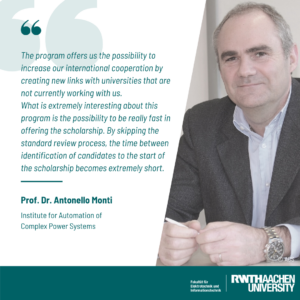
The Henriette Herz Scouting Program, funded by the BMBF, aims to expand and diversify the Alexander von Humboldt Foundation’s network. The program specifically recruits established and experienced researchers who already have an international network. It enables the scouts to select up to three scientists who will then directly receive a fellowship. The first will go to a female researcher.
The scouts aim to approach international researchers from abroad who have not yet been considered for an academic fellowship to the Humboldt Foundation and a research stay in Germany. As a result, the program will attract new collaborative partners for Germany, both from a specialist and geographical perspective. At the same time, the aim is to increase the quota of women sponsored in the Humboldt Research Fellowship Programme.
We are very pleased that Prof. Antonello Monti has been selected for the Henriette Herz Scouting Program.
“The program offers us the possibility to increase our international cooperation by creating new links with universities that are not currently working with us.
What is extremely interesting about this program is the possibility to be really fast in offering the scholarship. By skipping the standard review process, the time between identification of candidates to the start of the scholarship becomes extremely short.” – Prof. Monti

The Henriette Herz Scouting Program, funded by the BMBF, aims to expand and diversify the Alexander von Humboldt Foundation’s network. The program specifically recruits established and experienced researchers who already have an international network. It enables the scouts to select up to three scientists who will then directly receive a fellowship. The first will go to a female researcher.
The scouts aim to approach international researchers from abroad who have not yet been considered for an academic fellowship to the Humboldt Foundation and a research stay in Germany. As a result, the program will attract new collaborative partners for Germany, both from a specialist and geographical perspective. At the same time, the aim is to increase the quota of women sponsored in the Humboldt Research Fellowship Programme.
We are very pleased that Prof. Antonello Monti has been selected for the Henriette Herz Scouting Program.
“The program offers us the possibility to increase our international cooperation by creating new links with universities that are not currently working with us.
What is extremely interesting about this program is the possibility to be really fast in offering the scholarship. By skipping the standard review process, the time between identification of candidates to the start of the scholarship becomes extremely short.” – Prof. Monti
 The Henriette Herz Scouting Program, funded by the BMBF, aims to expand and diversify the Alexander von Humboldt Foundation’s network. The program specifically recruits established and experienced researchers who already have an international network. It enables the scouts to select up to three scientists who will then directly receive a fellowship. The first will go to a female researcher.
The Henriette Herz Scouting Program, funded by the BMBF, aims to expand and diversify the Alexander von Humboldt Foundation’s network. The program specifically recruits established and experienced researchers who already have an international network. It enables the scouts to select up to three scientists who will then directly receive a fellowship. The first will go to a female researcher.
The scouts aim to approach international researchers from abroad who have not yet been considered for an academic fellowship to the Humboldt Foundation and a research stay in Germany. As a result, the program will attract new collaborative partners for Germany, both from a specialist and geographical perspective. At the same time, the aim is to increase the quota of women sponsored in the Humboldt Research Fellowship Programme.
We are very pleased that Prof. Antonello Monti has been selected for the Henriette Herz Scouting Program.
(Deutsch) E.ON und RWTH verlängern Kooperationsvertrag Erfolgreiche Arbeit des E.ON Energy Research Centers wird weiter gefördert
CARL – Interdisciplinary Research Institution in Aachen

Copyright: KSG
A center for fundamental research into the ageing of battery materials and power electronic systems is currently being established at RWTH Aachen University. The “Center for Ageing, Reliability and Lifetime Prediction of Electrochemical and Power Electronic Systems“, CARL for short, is an interdisciplinary research facility where staff from ten core professorships and around 20 other chairs and institutes at RWTH Aachen and Forschungszentrum Jülich can conduct groundbreaking research. These include scientists from the disciplines of chemistry, physics, mathematics, computer science, materials science, mechanical and electrical engineering. The question of service life is essential when considering economic viability. For instance, this is important for car manufacturers, depreciation periods, warranties and to be able to assess reliability as part of functional safety.
Competence Cluster Battery Utilization Concepts (BattUtilization)

Copyright: ISEA
With the further spread of renewable energies and electromobility, powerful and reliable energy storage systems are becoming increasingly important. When is the secondary use of battery storage possible and for which applications is it useful? This question is being addressed by the project partners from research and industry in the new Battery Utilization Concepts ( BattNutzung) cluster, which is being funded by the German Federal Ministry of Education and Research with around 20 million euros. The cluster is coordinated by Prof. Sauer from ISEA. Together with the competence cluster greenBatt, the BattNutzung cluster forms the cross-sectional initiative “Battery Life Cycle”. This aims at a holistic view of second use and recycling concepts, which is to be enabled by linking the two clusters and through a cross-cluster exchange.
Professor Dirk Uwe Sauer is a new member of the Berlin-Brandenburg Academy of Science
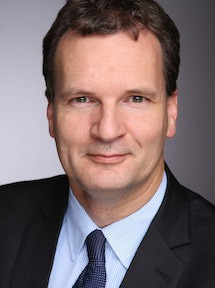 Professor Dirk Uwe Sauer is a new member of the Berlin-Brandenburg Academy of Science, which transcends disciplinary and national borders. For more than 300 years, the Academy has brought together outstanding scientists, among them 80 Nobel Prize winners. Professor Sauer is a member of the Academy’s technical science class. At our faculty, Professor Sauer holds the Chair of Electrochemical Energy Conversion and Storage Systems Technology. His chair is an integral part of the Institute for Power Electronics and Electrical Drives (ISEA), the Institute for Power Generation and Storage Systems (PGS), and the joint Helmholtz Institute HIMS with Forschungszentrum Jülich and the University of Münster. With his work, Dirk Uwe Sauer is significantly advancing the field of battery research in Germany, which is highly application-oriented. In addition to his actual research, he also always keeps an eye on the overall view of future energy systems, so that he can carefully evaluate alternative technologies along the time axis, such as hydrogen versus battery technologies. His expertise also makes him a sought-after advisor to policymakers: for example, he is a member of the German government’s National Platform for Electromobility and Platform for Mobility and is on the BMBF’s Battery Research Advisory Board.
Professor Dirk Uwe Sauer is a new member of the Berlin-Brandenburg Academy of Science, which transcends disciplinary and national borders. For more than 300 years, the Academy has brought together outstanding scientists, among them 80 Nobel Prize winners. Professor Sauer is a member of the Academy’s technical science class. At our faculty, Professor Sauer holds the Chair of Electrochemical Energy Conversion and Storage Systems Technology. His chair is an integral part of the Institute for Power Electronics and Electrical Drives (ISEA), the Institute for Power Generation and Storage Systems (PGS), and the joint Helmholtz Institute HIMS with Forschungszentrum Jülich and the University of Münster. With his work, Dirk Uwe Sauer is significantly advancing the field of battery research in Germany, which is highly application-oriented. In addition to his actual research, he also always keeps an eye on the overall view of future energy systems, so that he can carefully evaluate alternative technologies along the time axis, such as hydrogen versus battery technologies. His expertise also makes him a sought-after advisor to policymakers: for example, he is a member of the German government’s National Platform for Electromobility and Platform for Mobility and is on the BMBF’s Battery Research Advisory Board.
Further Information:
How catalysts become more active
Researchers from Jülich, Aachen, Stanford, and Berkeley have studied the layer-by-layer structure of catalyst material. They have discovered that a surface layer as thin as a single atom can double the activity for the reaction of water splitting – without increasing the energy consumption. This also doubles the amount of hydrogen produced.
The scientists hope that this increased understanding will allow developing better catalysts in the future to produce green hydrogen more energy-efficiently, and thus more cost-effectively, than before. Hydrogen is called green when it is produced by the electrolysis of water in a climate-neutral way using electricity from renewable sources. Hydrogen is regarded as an essential building block of the energy transition, partly because it can store wind and solar energy in times of oversupply and release it again later.
Part of the research results came about at the Peter Gruenberg Institute, Electronic Materials Division, in the Electronic Oxide Cluster Laboratory of Professor Regina Dittmann.
Original publication: ‘Tuning electrochemically driven surface transformation in atomically flat LaNiO3 thin films for enhanced water electrolysis’
C. Baeumer, J. Li, Q. Lu, A. Liang, L. Jin, H. Martins, T. Duchoň, M. Glöß, S. M. Gericke, M. A. Wohlgemuth, M. Giesen, E. E. Penn, R. Dittmann, F. Gunkel, R. Waser, M. Bajdich, S. Nemšák, J. T. Mefford, W. C. Chueh
Nature Materials, 11 January 2021, DOI: 10.1038/s41563-020-00877-1
Find further information on the website of the Jülich Research Centeer
5 Years Helmholtz Institut Münster “Center for Ageing, Reliability and Lifetime Prediction of Electrochemical and Power Electronic Systems” (CARL)
Powerful battery technology is a core element that benefits us in many everyday applications. From smartphones to wireless work devices and electric vehicles – batteries are shaping our lives to an ever-increasing degree.
Around 2012, the idea was born to combine the expertise of Forschungszentrum Jülich, RWTH Aachen University, and the University of Münster in battery research. Thus, 5 years ago now, the Helmholtz Institute Münster “Ionics in Energy Storage” was founded, which has now become a respected part of the battery research landscape and leads to the continuous development of research infrastructures at the different locations. In Aachen, this is reflected by the construction of the “Center for Ageing, Reliability and Lifetime Prediction for Electrochemical and Power Electronic Systems (CARL)”.
You can find further information in the Newsletter of ISEA
